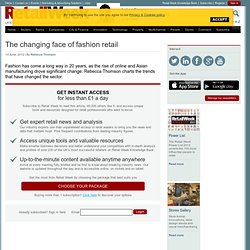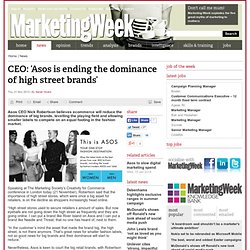

2011.13.9. Ready-to-Waste: The Ugly Side of Fast Fashion. Last month, Florida shopper Marie Wolf got a glimpse into the dark back alley of big retail when she stopped in at Victoria’s Secret to return a pair of Pink-brand sweatpants.

The clerk refunded her $70, no questions asked, and then reached for a pair of scissors and cut the pants in half. Wolf was outraged—the pants were unworn and perfectly sellable. She confronted the store manager and then the corporate office, only to find that the clerk’s biggest mistake—from a policy standpoint—was not that she’d cut up the pants, but that she’d done so in front of a customer. If Wolf’s story were the only one of its kind, you could label Victoria’s Secret’s a bad apple in a seemingly healthy orchard; but last year, H&M and Walmart were both caught destroying clothes.
As unsavory as it may be, destroying surplus inventory is not unheard of in big retail; the main reason is because companies want to protect their brand’s image. What Is Fast Fashion? And it works! Global 'fast-fashion' industry harming economy, environment, souls. In this lively indictment of the corporate clothing industry, a New York journalist explores how low-priced "fast fashion" -- the kind of "dirt cheap chic" clothes churned out for retailers like Forever 21 and H&M -- is wrecking the economy, the environment "and our souls. " Author Elizabeth L. Cline takes a broad look at "a powerful, trillion-dollar global industry that has too much influence over our pocketbooks, self-image and storage spaces.
" Overdressed is the result of a three-year investigation that took Cline to factories in China, where she passed herself of as an American manufacturer, sewed with Dominican labourers and visited what is left of New York's garment district, a skeleton of its storied past. It's true that fast fashion is one of the most radical things to happen to the fashion industry since, well, French king Louis XIV and his sidekicks created a fashion industry.
Today, however, fashion is one consumer area in which prices are actually coming down. No we aren't. The changing face of fashion retail. 13 June, 2012 | By Rebecca Thomson Fashion has come a long way in 20 years, as the rise of online and Asian manufacturing drove significant change.

Rebecca Thomson charts the trends that have changed the sector. Subscribe to Retail Week to read this article, 40,000 others like it, and access unique tools and resources designed for retail professionals who want to excel. Get expert retail news and analysisOur industry experts use their unparalleled access to retail leaders to bring you the news and data that matters most.
Plus frequent contributions from leading industry figures. Get the most from Retail Week by choosing the package that best suits you Choose your package Buying more than 1 subscription? Subscribe for less than £1 a day and get immediate online access. Choose your package Corporate buyer? Find out more. THE ASOS STRATEGY : THE AMAZING GROWTH OF ONLINE FAST FASHION. CEO: ‘Asos is ending the dominance of high street brands’ Asos CEO Nick Robertson believes ecommerce will reduce the dominance of big brands, levelling the playing field and allowing smaller labels to compete on an equal footing in the fashion market.

Speaking at The Marketing Society’s Creativity for Commerce conference in London today (21 November), Robertson said that the importance of high street stores, which were once a big asset for retailers, is on the decline as shoppers increasingly head online. “High street stores used to secure retailers x amount of sales. But now eyeballs are not going down the high street as frequently and they are going online. I can put a brand like River Island on Asos and I can put a brand like Needle and Threat, that no one has heard of, next to them. “In the customer’s mind the asset that made the brand big, the high street, is not there anymore. Nevertheless, Asos is keen to court the big retail brands, with Robertson claiming that his site can open up a new international market to British retailers.